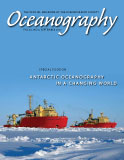First Paragraph
Regional warming around West Antarctica, including the Antarctic Peninsula, is related to the retreat of glaciers that has resulted in significant ice mass loss in recent decades (De Angelis and Skvarca, 2003). Large icebergs (> 18.5 km long) originating from ice shelves in the Ross and Weddell Seas (Scambos et al., 2000) are attributed primarily to major loss events in these regions. Once free, icebergs become entrained in the counterclockwise Antarctic Coastal Current (Figure 1), eventually entering a strong northward flow in the Northwest Weddell Sea. We examined free-drifting icebergs in the Atlantic sector of the Southern Ocean in December 2005, aboard ARSV Laurence M. Gould, and in June 2008 and March/April 2009, aboard RVIB Nathaniel B. Palmer. Prior to these studies, little information was available about the effects of icebergs on the pelagic realm. On these cruises, we investigated the “iceberg ecosystem” (Smith et al., 2007; Smith, 2011) to assess the degree to which icebergs are (1) hotspots of biological activity across multiple trophic levels, and (2) focal points for enhanced export of organic carbon to the deep sea. An important focus of this work was to examine the fundamental mechanisms by which icebergs affect the pelagic ecosystem, including physical disruption and effects on the availability of critical nutrients (e.g., iron, nitrate).

